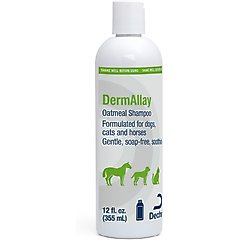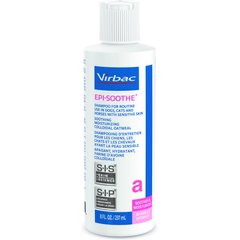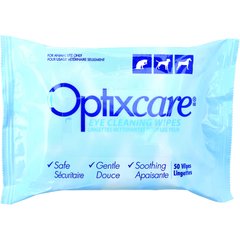How to Bathe a Cat: Step-by-Step Tips From a Professional Groomer
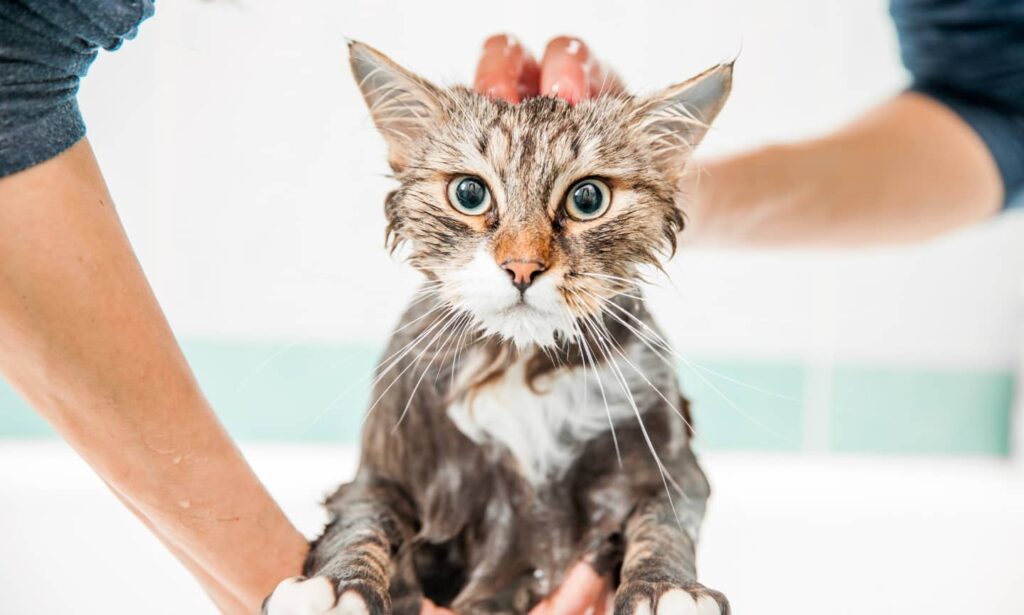
Photo by iStock.com/CasarsaGuru
Picture this: Your kitty has rolled in something sticky or stinky and needs a bath ASAP, but the groomer can’t get you in right away. What do you do? Bathe your cat at home, of course.
You don’t need a pro to wash something gross off your cat. You just need the right cat bathing supplies and clear instructions. Here’s how to bathe a cat.
Do Cats Need Baths?
Cats are typically self-cleaning creatures, and many kitties can go their whole lives without needing a bath. But some cats require them, either on an occasional or regular basis.
Pro Tip: Use positive reinforcement and clicker training to help your cat become acclimated to taking a bath.
Here are a few instances where you may need to know how to give a cat a bath:
- You have a hairless breed. Hairless cats need regular baths with medicated shampoo to remove excess oil from their skin.
- You have a long-haired cat. Even if you keep your cat well-brushed, long-haired breeds might struggle to keep themselves clean.
- Your cat can’t clean themselves thoroughly because they are obese, arthritic, or elderly.
- Your cat has fleas, lice, or another parasite. You may need to bathe your cat with a special shampoo.
- Your cat has a bacterial, yeast, or fungal (ringworm) skin infection. Your vet may recommend a bathing program with a medicated shampoo.
- Your cat gets into something. Cats tend to get into sticky situations—sometimes literally! If your cat is sticky, smelly, oily, greasy, grimy, or otherwise dirty, they’ll need your help to get clean.
If your cat dislikes water, only bathe them if you absolutely have to. It’ll save stress for both you and your kitty.
Cat Bathing Supplies
Make sure you have all your cat bath supplies ready before you start. One of the main things you’ll need is cat shampoo—but before you lather up your kitty, keep these tips in mind:
- Choose a shampoo specifically for cats. Not all dog shampoo is safe for cats, so read labels carefully to make sure the shampoo is formulated for cats, too.
- Follow the directions on the label. Some shampoos need to be diluted before being used on pets. Failing to do so can irritate your cat’s skin, so always read the label and follow the instructions.
Recommended Products
You’ll also need these items:
Recommended Product
- Treats
- A bathmat, towel, or another non-skid surface for the bottom of the tub or sink
- A spraying faucet attachment, like the Ownpets Combing Shower Sprayer. If your cat isn’t comfortable with the sprayer yet, use a cup or water pitcher to rinse your cat.
Recommended Product
- Grooming wipes made for wiping the eyes and face, like Optixcare Eye Cleaning Wipes
Recommended Product
- Plenty of towels
- Cotton balls
- Conditional (optional)
- A pet grooming loop, such as Coastal Pet Products Adjustable Nylon Grooming Loop (optional)
- A pet dryer, like the Flying Pig Grooming High Velocity Dryer (optional)
Recommended Product
- An extra pair of hands (optional, but extremely useful!)
Preparing for Your Cat’s Bath
Set yourself up for success by following these tips before you bathe your cat.
- Cut your cat’s nails: Long, sharp nails will hurt more if your kitty scratches you, so trim your cat’s nails first. You can do this the day before, so your kitty isn’t already stressed when you start washing them.
- Brush and comb your kitty: Some people wash their cats when they have mats, thinking the bath will make the knots easier to brush out. In fact, the opposite is true. Water makes mats worse, so make sure to demat and brush your kitty before the bath. Again, you can do this the day before.
- Get everything ready: You don’t want to have a wet cat in your hands when you realize you’ve forgotten something. Make sure your supplies are handy before fetching your cat.
- Tire your cat with playtime: A tired cat will be less motivated to attempt an escape during bath time, so wear your kitty out with a wand teaser or another favorite toy. When they’re too tired to play anymore, it’s time for the bath.
Recommended Products
How To Hold Your Cat
If your kitty is new to bathtime, they may try to get away by any means necessary. For that reason, using a grooming loop is helpful.
Recommended Product
Grooming loops are essentially tethers that wrap around your pet and attach to something stable in your home. For your cat’s bath, tether their loop to the faucet of your sink or bathtub.
When it comes to grooming loops and cats, placement is everything. Do not put the grooming loop around your cat’s neck—your cat could strangle themselves if they try to escape with a loop around their neck.
Instead, position the grooming loop over one shoulder and under the opposite armpit, so it wraps diagonally across their chest, like the shoulder strap of a seat belt.
How To Bathe a Cat Step by Step
OK, you’ve done your prep work and have your supplies ready. Here’s how to give a cat a bath.
1. Wet Your Cat From the Ears Back
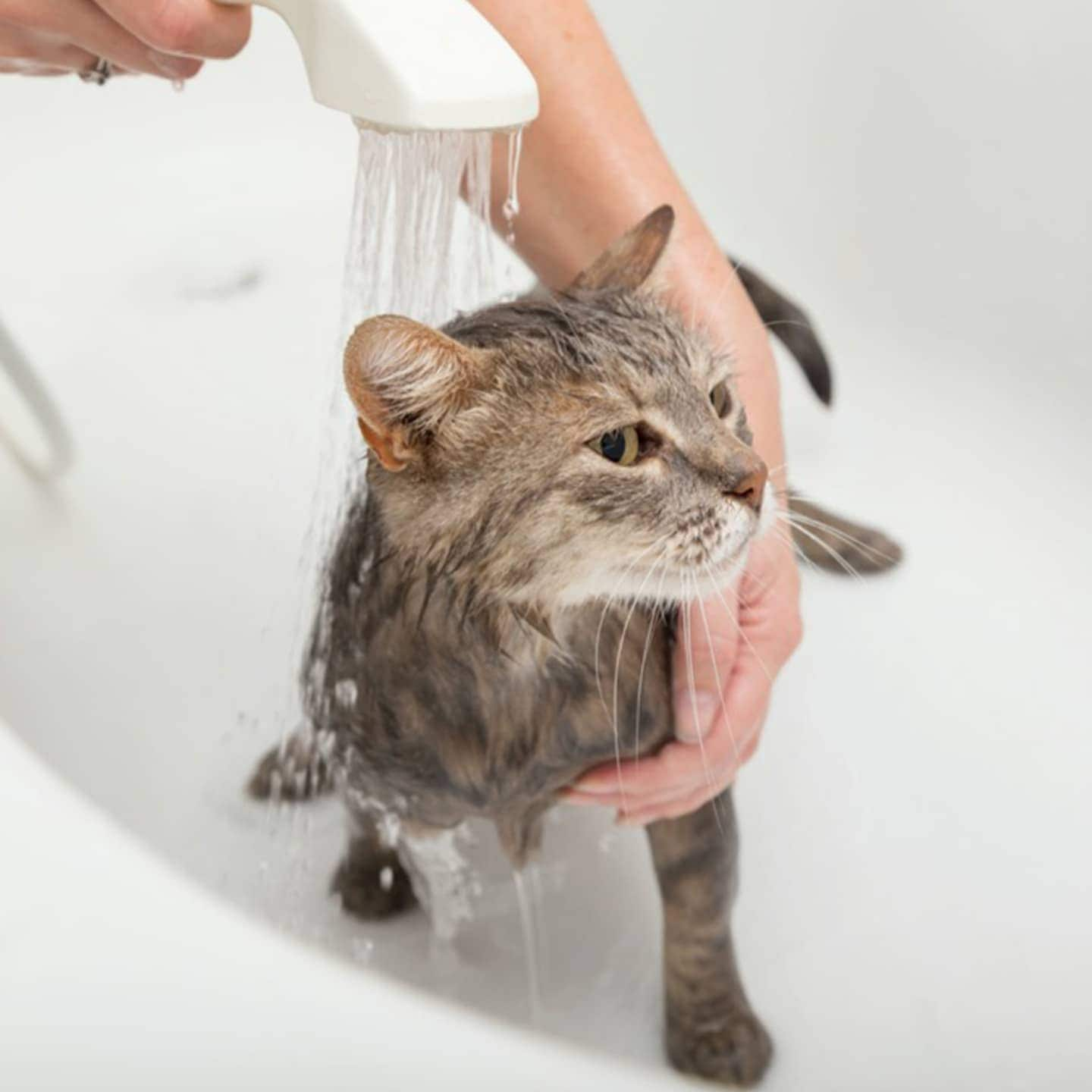
iStock.com/vladans
Using a sprayer or pitcher, wet your kitty from behind their ears to their tail.
You can use a sprayer, a cup, or even your cupped hand to wet their underside. If necessary, carefully use one hand under their front legs to lift them up to wet the underside.
Try to avoid getting your cat’s head wet, especially around the ears. Excess moisture in your cat’s ears could cause an infection.
Make sure the water isn’t too hot or cold. Cats’ skin is especially sensitive, so keep the water lukewarm to ensure they’re comfortable.
2. Apply Shampoo and Lather
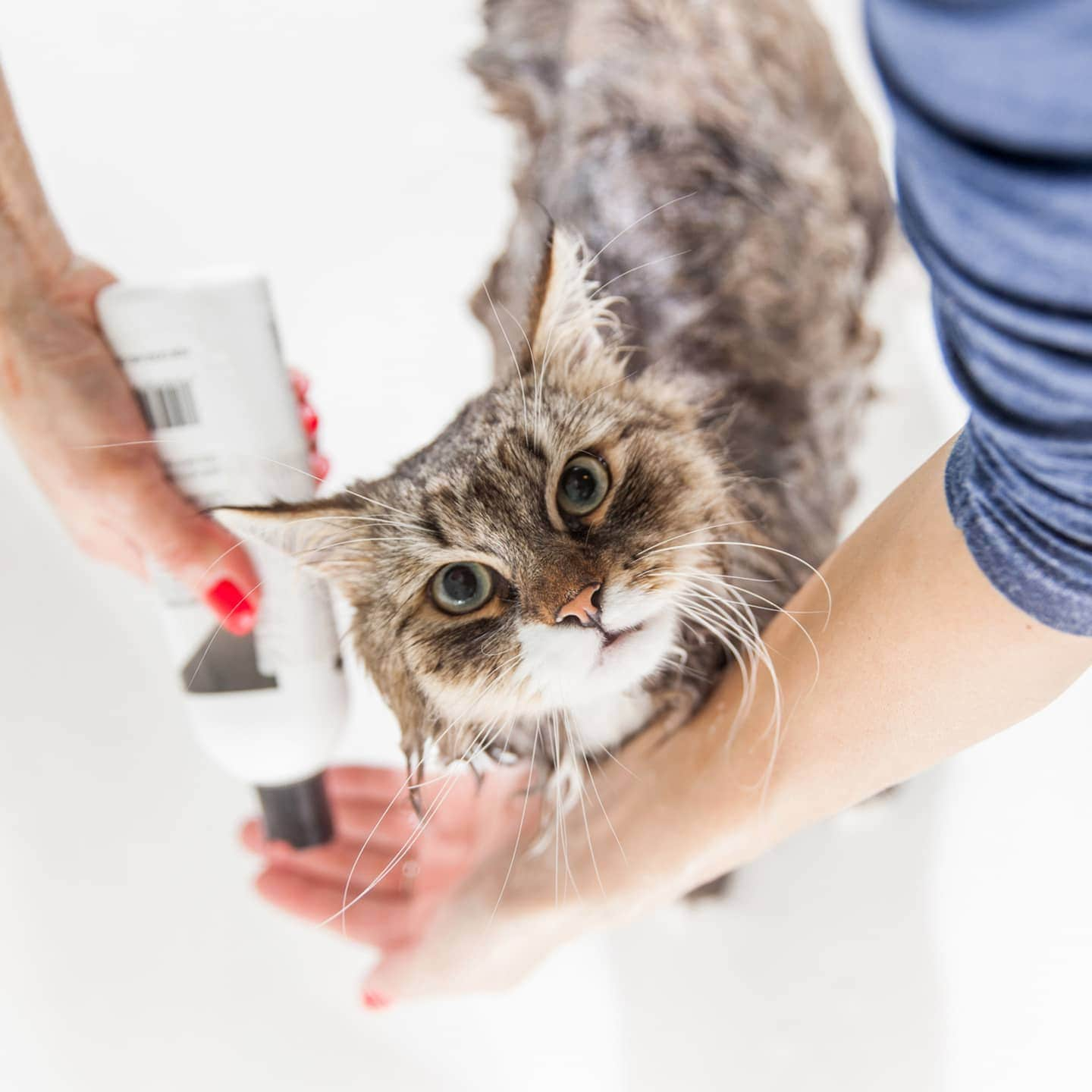
iStock.com/CasarsaGuru
Following the directions on the shampoo bottle, lather your kitty from the neck down, paying particular attention to their genitals and under their legs.
Make sure not to get any shampoo in your kitty’s eyes. If you have help, one person can hold the cat while the other scrubs.
Remember to read the shampoo label carefully and closely follow the instructions. Some shampoos need to be diluted before use.
3. Rinse (And Rinse Again!)
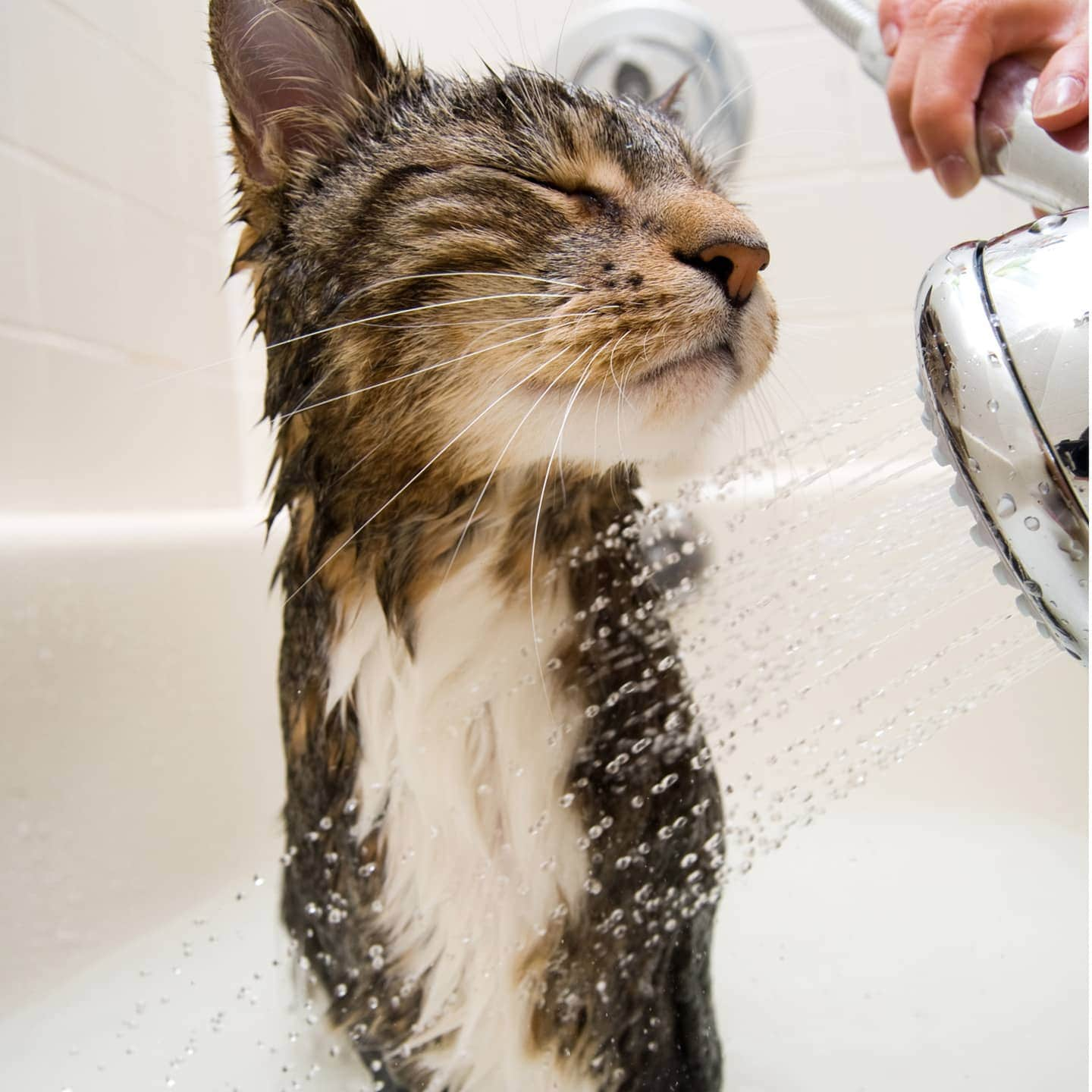
iStock.com/WebSubstance
Shampoo residue can irritate your kitty’s skin, so ensure it’s all washed away. When you think you’ve thoroughly rinsed your cat, check every nook and cranny—then rinse again.
For cats with long hair or dry skin, you may want to apply a cat-safe conditioner after you rinse the shampoo out. Just make sure you rinse well afterward!
4. Wipe Your Cat’s Face and Clean Their Ears
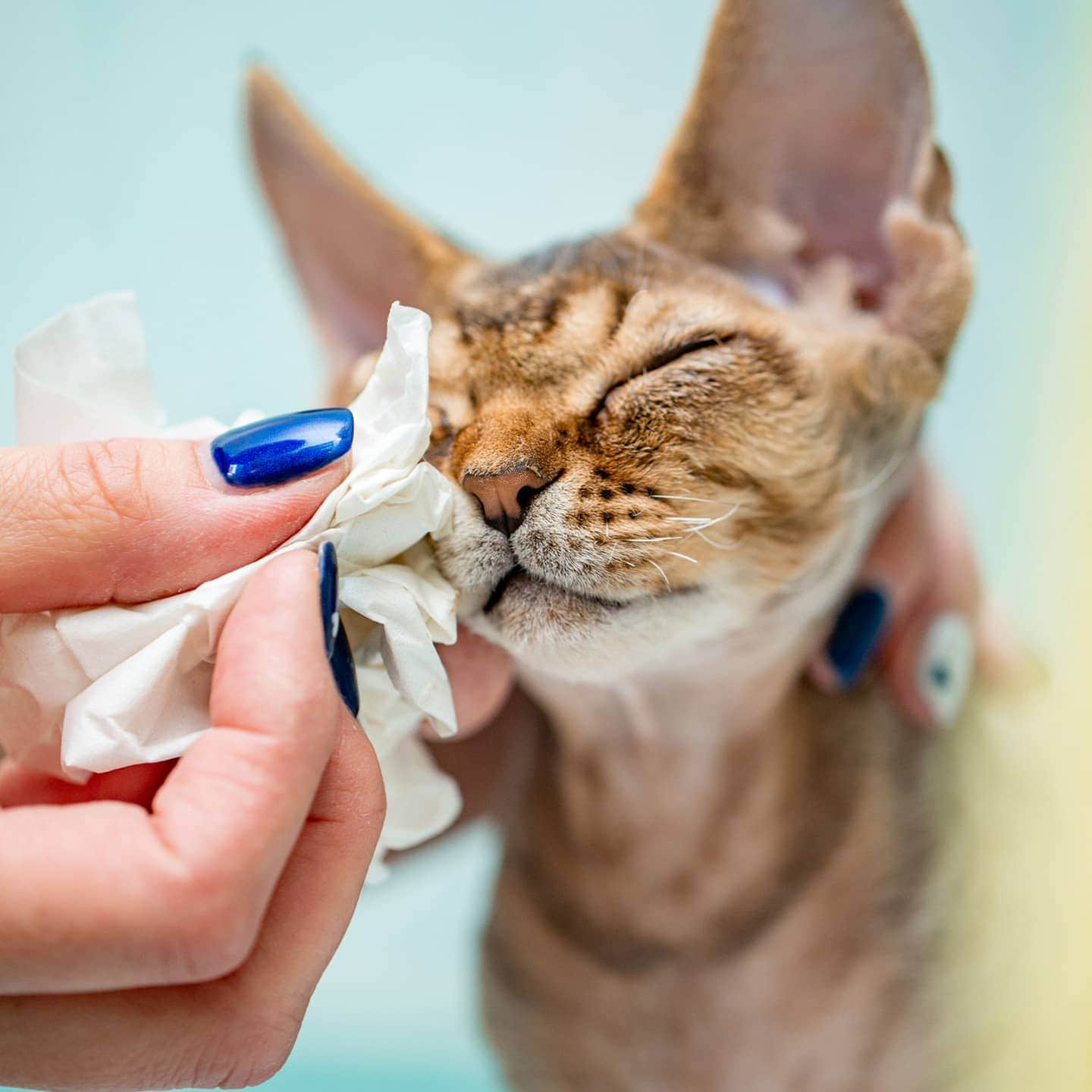
iStock.com/CasarsaGuru
Use a grooming wipe or a damp washcloth to wipe your cat’s face. Follow the directions on the ear cleaner to clean your cat’s ears with a cotton ball.
5. Dry Your Cat
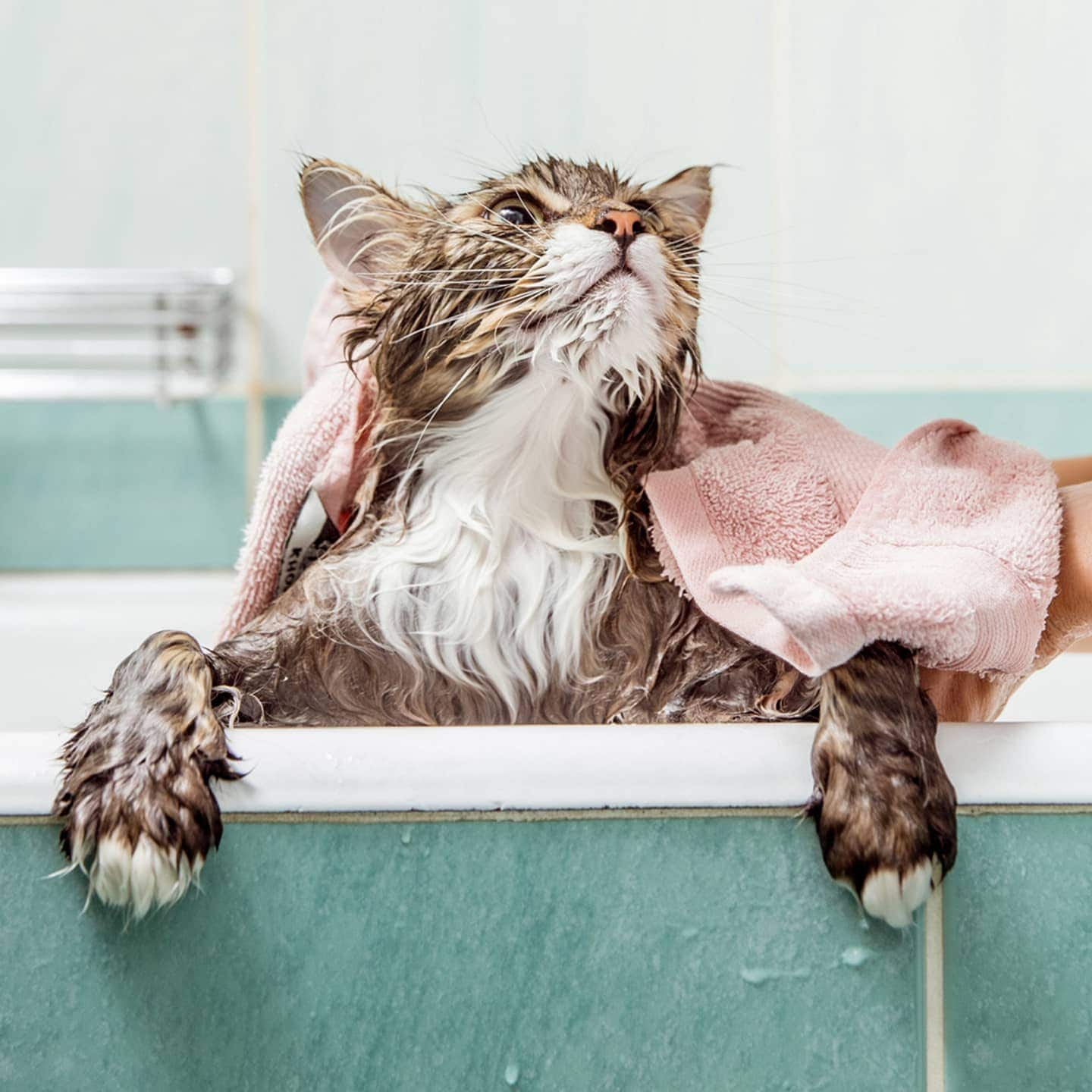
iStock.com/CasarsaGuru
Towel-dry your cat as well as you can. If your cat tolerates it, you may want to try using a dryer on a low, cool setting—but note that the sound could scare your kitty.
Remember: When using a dryer, you shouldn’t use any heat settings.
6. Reward Your Kitty

iStock.com/1001slide
Once you’ve finished, give your cat plenty of treats, playtime, snuggles, or whatever their favorite thing is.
Treating your cat at the end of the bath helps to end the experience on a positive note—and maybe, just maybe, it’ll help them look forward to the next time they need a bath.
Tips for Keeping Your Cat Calm
Keeping your kitty relaxed and happy will make the bath easier for both of you. Here are some tips for keeping your cat calm:
- Use a Feliway diffuser, which uses pheromones to help your cat feel safe and secure.
- Keep yourself calm. If you’re stressed, your cat will feel it—and they might react with stress behaviors of their own. So, practice deep breathing, put on some relaxing music—anything to keep your own anxiety down.
- Place a mat or wet towel in the bottom of the sink or tub. This will give your cat secure footing so they can check “slipping and falling” off their “to-worry-about” list.
- Offer plenty of treats, both during and after the bath. Your cat’s more likely to stay calm if there’s a tasty treat in store for them.
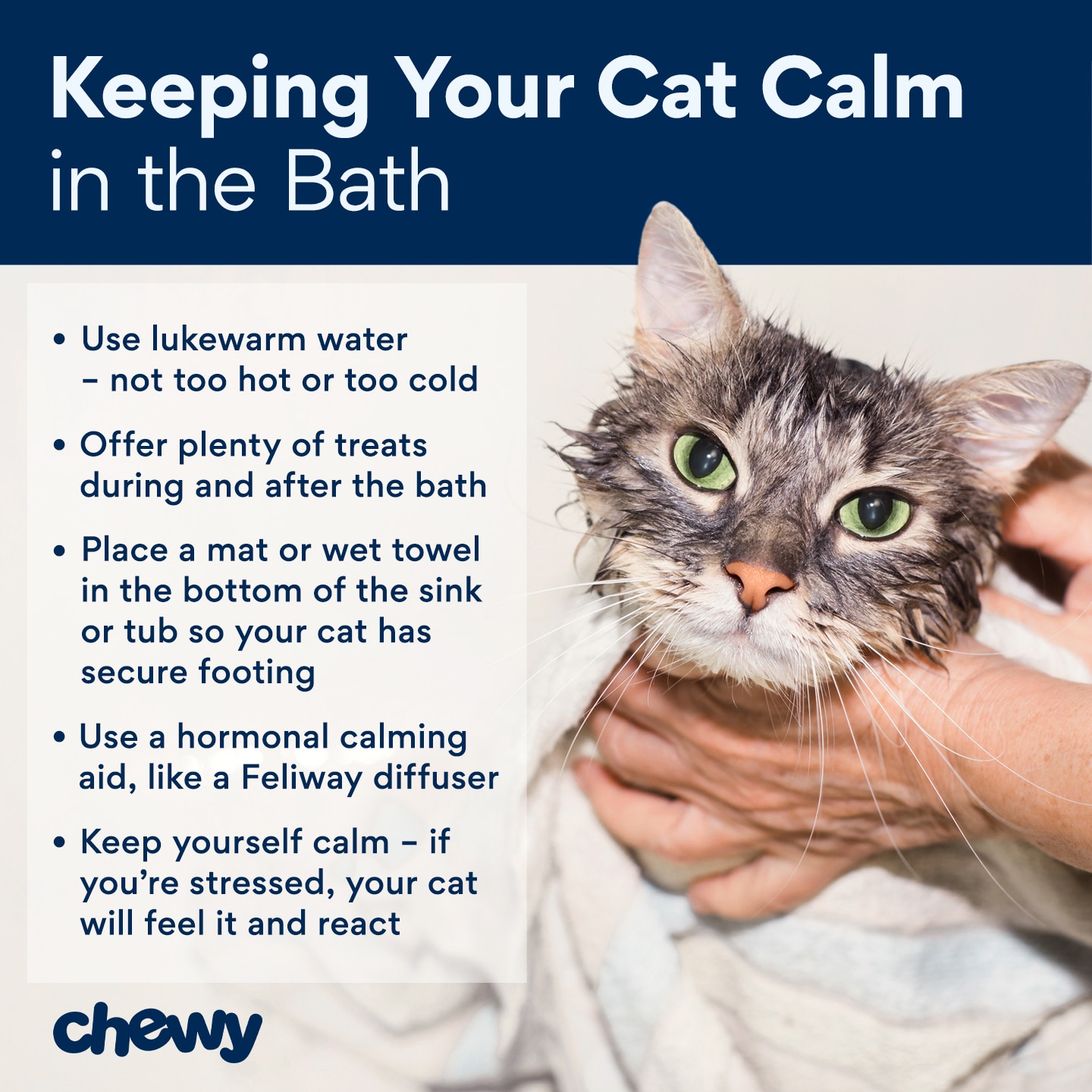
FAQs About Bathing Cats
How often should you give your cat a bath?
Most cats only need baths when they get dirty or stinky, and many cats can go their whole lives without being bathed. But there are a few types of cats who need regular baths:
- Hairless cats need baths every week or so to help keep their skin moisturized and not overly oily.
- Long-haired cats or cats who can’t groom themselves may need a bath every month or two.
Speak with your vet about how often you should bathe your cat and which shampoo is best for your kitty.
How do you bathe a cat who hates water?
To help your cat get used to being bathed, take small steps using positive reinforcement and clicker training.
Have your sink or bathtub already filled with a few inches of lukewarm water and a nonslip mat. Gently lower your cat into the water, praise your cat with a soothing voice, then remove your cat from the sink or tub and dry them with a towel. Offer your cat lots of love and treats to make bathing a positive experience.
Over time, work up to longer bathing sessions where you scoop water onto your cat’s back with a cup or your hand. Finally, work up to adding shampoo, rinsing thoroughly with water.
Is it OK to never bathe a cat?
Yes, it’s totally OK to never bathe your cat. Most cats are excellent groomers and keep themselves clean. But there are times where it may be necessary to bathe your cat, such as if you have an elderly cat who isn’t grooming properly.
Can I use Dawn to wash my cat?
Yes, dish soaps such as Dawn can be used to bathe a kitten or cat in an emergency situation, as the soap can help drown live fleas and remove greasy, oily residue.
But because Dawn can dry out and irritate your cat’s skin and coat, it’s safer to use mild shampoos like DermAllay Oatmeal Shampoo. For cats with fleas, use Advantage Flea &Tick Treatment Shampoo along with flea medication from your vet.
Attributions
This content was medically reviewed by Molly Price, DVM, Chewy veterinarian.
